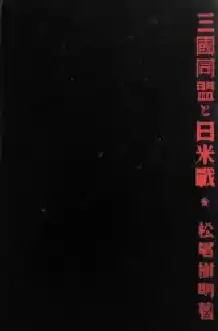 | |
| Author | Kinoaki Matsuo |
|---|---|
| Original title | The Three-Power Alliance and the United States-Japanese War |
| Translator | Kilsoo Haan |
| Country | United States |
| Language | English |
| Publisher | Little, Brown and Co. (Boston) George G. Harrap and Co. (London) |
Published in English | 1942 |
| Media type | |
| Pages | 323 (Little, Brown and Co.) 240 (George G. Harrap and Co.) |
| OCLC | 4674240 |
| Text | How Japan Plans to Win at Internet Archive |
How Japan Plans to Win is the English translation of The Three-Power Alliance and the United States-Japanese War, a work of current events by Kinoaki Matsuo, a Japanese Foreign Affairs Officer, Navy Admiralty Liaison, Navy strategizer, and member of the Black Dragon Society. The English translation was performed by Kilsoo Haan, a Korean anti-Japanese operative living in the United States. It was published in 1942 simultaneously in Boston by Little, Brown and Company (323 pages) and in London by George G. Harrap and Company (240 pages). The book was reviewed in such publications as The New York Times and the Council on Foreign Relations journal, Foreign Affairs.
The book was originally published in Japan by the Foreign Office Press in late 1940.[1] It has been described by some historians as the Japanese counterpart to the United States government contingency plan War Plan Orange.[2]
Synopsis
Kinoaki predicts an impending attack on Japan by the United States that will leave no alternative to an existential war of attrition between the two powers, pitting Japan against an arrogant, racist enemy and overwhelming odds.[2]
Controversy
A copy of the book is alleged to have been stolen from Kinoaki himself by the book’s translator, Kilsoo Haan.[2]
Some Japanese sources allege that the book is actually a work of propaganda, intended to lift civilian morale and reassure the public of that Japan will have a chance for a negotiated peace in the event it finds itself coerced into war with the United States.[2]
One reviewer described the book as being "on a level far beneath Mein Kampf."[3]
Covers
The version published in Boston by Little, Brown and Company featured a reproduction of the Japanese book cover and endsheets. This entailed black cloth boards with the Japanese title in red, vertically, along the right side of the cover. The endsheets were emblazoned with a red and white naval theme.[4]
The book published in London by George G. Harrap and Company featured tan cloth boards without a title on the front or back covers.
Reviews
- Chamberlain, William Henry (Apr. 26, 1942). "A Pep Talk for the Japanese." Review of How Japan Plans to Win, by Kinoaki Matsuo. The New York Times. p. BR18.
- Woolbert, Robert Gale (Jul. 1942). Review of How Japan Plans to Win, by Kinoaki Matsuo. Foreign Affairs, vol. 20, no. 4. p. 785.
- Ainger, E. (Sep. 1942). Review of How Japan Plans to Win, by Kinoaki Matsuo. International Affairs Review Supplement, vol. 19, no. 9. pp. 519–520.
References
- ↑ Woolbert, Robert Gale (Jul. 1942). Review of How Japan Plans to Win, by Kinoaki Matsuo. Foreign Affairs, vol. 20, no. 4, p. 785. Archived from the original.
- 1 2 3 4 Koster, John (2012). "War Plan Orange." In: Operation Snow: How a Soviet Mole in FDR's White House Triggered Pearl Harbor. New York: Regnery, pp. 66–67. ISBN 978-1596983298.
- "A Japanese counterpart to War Plan Orange was set out in The Three-Power Alliance and the United States–Japanese War, published in Japan in late 1940 and said to have been written by a Naval officer named Matsuo Kinoaki [sic], a member of the ultra-nationalist Black Dragon Society. Kinoaki predicted an American attack on Japan, followed by a fight for national survival against an arrogant and racist enemy and overwhelming odds. Kilsoo Haan, a Korean anti-Japanese operative living in the United States, claimed to have stolen a copy of the book from Kinoaki himself. Little, Brown and Co. published Haan’s English translation in 1942 under the title How Japan Plans to Win. Japanese sources suggest that the book was actually written by a Japanese propagandist to reassure the public that Japan would have a chance for a negotiated peace if forced into war with the United States. Kilsoo Haan passed off this morale-building propaganda as inside information."
- ↑ Ricketts, Edward F. (2013). "Geopolitical Intelligence and Strategies of War." The Steinbeck Review, vol. 10, no. 1. pp. 50-62. doi:10.5325/steinbeckreview.10.1.0050.
- "This purports, and I see no reason for doubting it, to be a sort of Japanese Mein Kampf brought into this country for propaganda purposes by agents working among the California Japanese. Both books are concerned with schedules of conquest which seem to be working out to date, and both are reminiscent in their jingoist implications of Hitler's writings. But neither compel my respect. They are on a level far beneath Mein Kampf."
- ↑ "How Japan Plans to Win". WorldCat. Archived from the original on 7 July 2019.
- "Reproduction of the cover of the Japanese edition on lining-papers."
External links
- Full text at Internet Archive
- Kilsoo Haan at Densho Encyclopedia
- How Japan Plans to Win in libraries (WorldCat catalog)
- 松尾樹明『三國同盟と日米戰』霞ヶ關書房 1940.10 増補改訂版 (English: The Three-Power Alliance and a United States-Japanese War). Foreign Office Press, 1940.